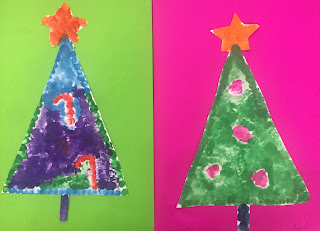A year of wonderful artworks created by my 340 students, from Foundation to Year 6, at Kerrimuir Primary School near Melbourne, Australia.
Saturday, 10 December 2016
The End of the School Year
A year of wonderful artwork is nearly at its end. Students have learned new skills and used new materials. They’ve completed amazing artworks and persevered when lessons have been challenging, especially this term in weaving. My on-going philosophy in teaching, especially with the younger grades, is the idea of “beautiful oops”, i.e. there are no mistakes in art, only new opportunities to make something beautiful. Older students have considered the “embrace the shake” approach, based on an inspiring TED talk of the same name. This is all about looking at any limitation we might have as a chance to problem-solve and think creatively in art, and more importantly, generally, in life.
Year 2 Fingerprint Tree Christmas Card
Students used their fingers as a tool to paint prints to make a colourful tree. They cut this out and displayed it on a A4 background sheet, to complete their Christmas card.
Years 5 & 6 Wire & Bead Ornament
Students made textured stoneware clay beads last term and then painted them. They used these along with floral wire, gold beads and bells to create original ornaments.
Wednesday, 7 December 2016
Saturday, 3 December 2016
Year 6 Colour Theory Layered Tape Painting
Students alternated paint layers with masking tape to achieve an amazing effect. The colours they had to work with for the layers were as follows: first layer - primary colours, second - one secondary colour with a white tint, third - complementary colours, and fourth - black and white.
Year 4 - 6 Stoneware Clay Beads
Students modeled textured beads and then painted the beads after they had been fired in the kiln. We will be using the beads to make Christmas ornaments.
Labels:
acrylic paint,
beads,
stoneware clay,
texture,
year 4,
year 5,
year 6
Embrace the Shake TED Talk




Year 3 Quilling
During the Renaissance, French and Italian nuns and monks used quilling to decorate book covers and religious items. The paper most commonly used was strips of paper trimmed from the gilded edges of books. These gilded paper strips were then rolled to create the quilled shapes. Students tried their hand at this paper art with fantastic results!
Subscribe to:
Comments (Atom)















